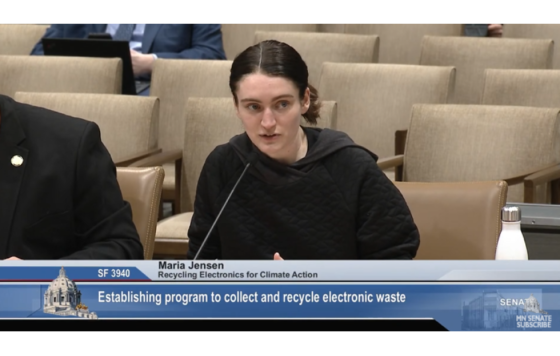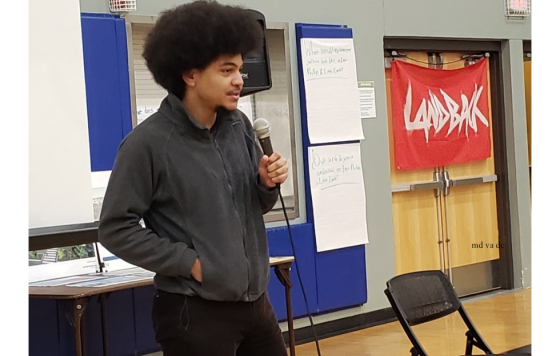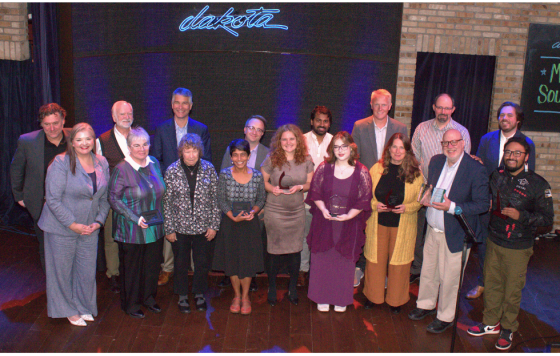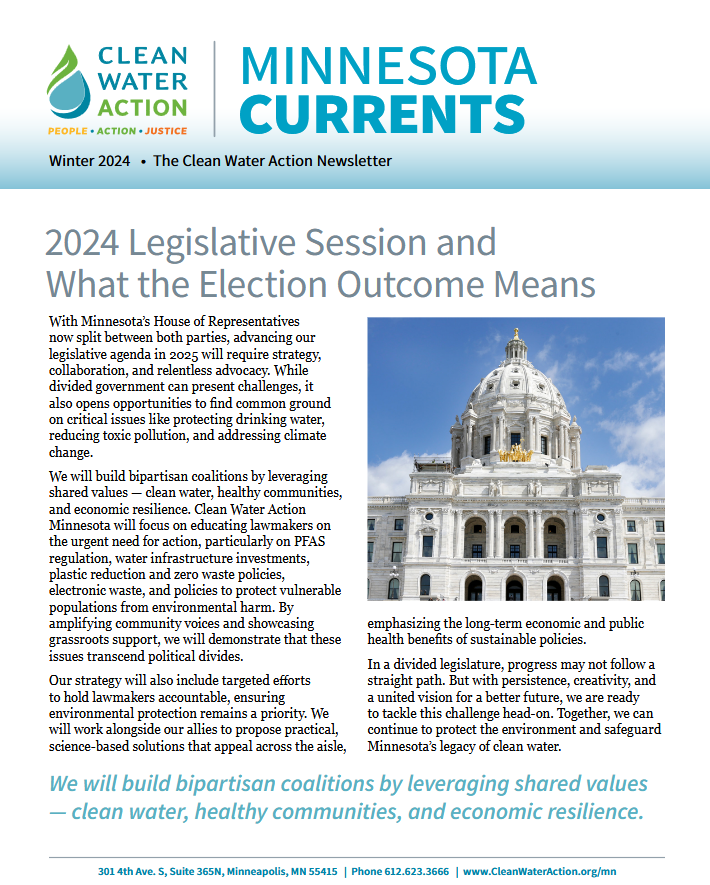In This Issue
- 2024 Legislative Session & What the Election Outcome Means
- Tackling The Problem Of E-Waste
- Environmental Justice: Wins and Goals
- Procurement and You
- National Updates
- 2024 Election Results and Our Work
- The Safe Drinking Water Act: 50 Years of Progress — But the Work is Never Finished
- A Win for Our Water: Progress On Getting Lead Out Of Drinking Water
- Brunch For Better
2024 Legislative Session & What the Election Outcome Means
With Minnesota’s House of Representatives now split between both parties, advancing our legislative agenda in 2025 will require strategy, collaboration, and relentless advocacy. While divided government can present challenges, it also opens opportunities to find common ground on critical issues like protecting drinking water, reducing toxic pollution, and addressing climate change.
We will build bipartisan coalitions by leveraging shared values—clean water, healthy communities, and economic resilience. Clean Water Action Minnesota will focus on educating lawmakers on the urgent need for action, particularly on PFAS regulation, water infrastructure investments, plastic reduction and zero waste policies, electronic waste, and policies to protect vulnerable populations from environmental harm. By amplifying community voices and showcasing grassroots support, we will demonstrate that these issues transcend political divides.
Our strategy will also include targeted efforts to hold lawmakers accountable, ensuring environmental protection remains a priority. We will work alongside our allies to propose practical, science-based solutions that appeal across the aisle, emphasizing the long-term economic and public health benefits of sustainable policies.
In a divided legislature, progress may not follow a straight path. But with persistence, creativity, and a united vision for a better future, we are ready to tackle this challenge head-on. Together, we can continue to protect the environment and safeguard Minnesota’s legacy of clean water.
Tackling The Problem Of E-Waste
Climate change solutions are in jeopardy without an increase in critical metals to produce new products at a scale. Things like solar panels, wind turbines, EVs and geothermal technology all require critical metals, and lots of them. At the same time, we are literally throwing billions of dollars’ worth of these critical metals into landfills across Minnesota and around the world. A 2023 pilot study “The Economic Potential of E-Waste Recycling in Minnesota” identified over 3 billion dollars’ worth of valuable metals that are mostly being landfilled via electronic waste every year—in Minnesota alone. Electronics recycling is the least expensive, quickest, and most environmentally friendly approach to sourcing these metals and Clean Water Action is fighting to make it happen in Minnesota.
Currently, it is estimated that only 20% of electronic waste in Minnesota is recycled, and though e-waste only makes up 2% of the material in our landfills, it contributes 70% of the lead pollution present in our waste streams. By increasing collection rates, we can not only obtain sustainable critical metals for the energy transition – but also prevent toxic pollution to our water.
Clean Water Action Minnesota has recently hired Maria Jensen as an e-waste organizer. Jensen has years of metals recycling industry experience and is the original author of the 100% e-Waste Recycling bill, as well as the primary author of the “The Economic Potential of E-Waste Recycling in Minnesota” pilot study.
The 100% e-Waste Recycling bill will make Minnesota the first state in the country to have universal, free recycling for all types of end-of-life electronics and will propel MN towards the goal of 100% recycling of e-metals. The bill will require producers, largely huge multinational manufacturing companies like Apple, Samsung and Lenovo to pay for electronic waste collection costs. By creating a comprehensive collection system, this piece of legislation will create an additional 1700 jobs in the State. The campaign enjoys bi-partisan legislative support as well as support from the waste industry; the mining industry; county governments; state agencies, local labor unions, environmental, and environmental justice organizations, faith-based organizations, solar companies and the farmers union. We fully expect this bill to pass this session, and for Minnesota to become a leader in electronic waste recycling.
E-Waste Organizer Maria Jensen testifies in Minnesota State Senate for the 100% Electronics Recycling bill.
The 100% e-Waste Recycling bill will make Minnesota the first state in the country to have universal, free recycling for all types of end-of-life electronics and will propel MN towards the goal of 100% recycling of metals from electronic waste. Electronics recycling will provide metals for renewable energy products like solar panels, wind turbines, and geothermal energy technology and create local green jobs, and Clean Water Action Minnesota is leading the way!
Environmental Justice: Wins and Goals
This year was quite eventful in the environmental justice movement in Minnesota. We saw huge wins in longstanding fights, communities taking a stand against industrial pollution, new fights emerging, and ongoing work to create the systemic changes our frontline communities need.
Smith Foundry
Last year the EPA conducted a series of surprise investigations in Minnesota, uncovering multiple polluting facilities that were violating their permits. One site that stood out was Smith Foundry, in the East Phillips neighborhood. Upon learning about these violations, the community took swift action. People showed up in droves to MPCA public meetings on the issue, sharing their personal stories of living with pollution all around them, and how it has affected their friends and family.
Eventually, after much community pressure, Smith Foundry reached a settlement with the EPA to become an etching and finishing facility, vastly reducing their emissions. Then, just a few months later, the facility announced it was leaving East Phillips for good. Now the community is having conversations about what the future of the site looks like.
HERC
Thanks to the incredible organizing of the Zero Burn coalition, led by the MN Environmental Justice Table, the campaign to shut down the polluting HERC trash incinerator has been gaining support and momentum. Their constant organizing, political advocacy, and power building culminated in a Minneapolis city council resolution to shut down the HERC by 2028, which passed unanimously. While there is still work to be done to pressure Hennepin County, this was an enormous milestone in the campaign. Now we need to carry that momentum into 2025 to get HERC fully shut down!
Cumulative Impacts
This year was the first real year of rulemaking for the Cumulative Impacts law of 2023. The MPCA is engaging in ongoing community and stakeholder outreach and engagement to determine how they will implement the cumulative impacts law, with a lot on the line. This year, the agency held a series of public co-learning sessions in the Spring, followed by community meetings over the summer and fall. So far, we have seen interest from a number of different communities in ensuring these rules protect them from pollution, but we’ve also seen plenty of industry and commerce representatives showing up to try and weaken the rules.
We still have a lot of work to do, with next year being crucial. We need to ensure that the rules the MPCA drafts are based on the needs and voices of our most overburdened communities. Stay tuned for more opportunities to learn about this issue and engage in the rulemaking process.
Sasha Lewis-Norelle, Environmental Health and Justice Organizer, speaking at an East Phillips community event on the cumulative impacts law and how it connects to Smith Foundry
As we know, taxes are one of life’s great inevitabilities. We all agree that our tax dollars should be spent responsibly and wisely, and the environmental impacts of tax dollar purchases, whether positive or negative, should be part of any purchasing analysis. Procurement is the process our local, state, and federal governments use to make these purchasing decisions with taxpayer dollars. These purchases include a wide range of purchases from cleaning products for county-owned libraries to the asphalt used by MNDOT for road repairs, and everything in between. As it stands now, our procurement statutes in Minnesota are quite good, but can certainly be improved upon.
One way to improve our existing statutes is to include life cycle and hazard assessments in the purchasing decision criteria. By considering the full life cycle of any given product, including the environmental and health impacts of manufacturing and end-of-life management, we can better position ourselves to maximize the value of taxpayer money spent, and minimize detrimental environmental effects. These additional tools can also help to identify material candidates for reuse, such as construction materials, which will minimize the need for fresh materials being produced and used in new projects, further minimizing our negative impacts on the environment.
So why should you care? Well, if protecting the environment and requiring more fiduciary responsibility of our tax dollars isn’t enough, there’s another benefit: jobs. Government purchasing has a significant impact on the market. If Minnesota as a state tells producers and manufacturers that we’re only purchasing safe, sustainable goods, those businesses will adapt their production to stock those items - shifting the market toward those safe, sustainable products. It is very likely these businesses would need to expand their operations to meet their customers’ demands, meaning they’d need to hire more staff. New startups are already showing that there is a serious demand for reused and upcycled construction materials, signaling an emerging industry requiring thousands of new jobs.
2024 Election Results and Our Work
We’re proud of our work to motivate clean water voters in the recent elections. See our state updates in this issue. The impact of the election on our national level work will, unfortunately, be dramatic. The new administration has committed to gutting federal agencies, rolling back health and environmental protections, and to taking us backwards on addressing the climate crisis. Among its priorities are further weakening the Clean Water Act’s stream and wetlands protections, despite the devastation already caused by the U.S. Supreme Court’s decision in Sackett v. EPA. Both the U.S. House of Representatives and the U.S. Senate will be controlled by a party now seemingly hostile to strengthening environmental and health protections. Many members are committed to extreme federal budget cuts. We know that despite this rather dire reality, people’s voices matter and our work can make a difference. We will be working to oppose anti-regulatory initiatives, to protect the clean water and clean air protections that the public supports, and to stand up for effective government that implements our landmark environmental laws to make people and our communities healthier.
The Safe Drinking Water Act: 50 Years of Progress — But the Work is Never Finished
The Safe Drinking Water Act (SDWA) was signed into law by President Gerald Ford on December 16, 1974. The goal of the nation’s first comprehensive drinking water law was to reduce risks to public health from drinking water. The law ushered in remarkable improvements and technical innovation in drinking water treatment and distribution. Still, the task is never complete. Clean Water’s work around drinking water is focused on ensuring that we maintain the collective commitment to ensuring safe drinking water for all. Priority issues include:
- Making sure SDWA’s contaminant limits keep up with health science around long-known contaminants like nitrates and arsenic and that regulations address “emerging” contaminants like microplastics
- Ensuring ongoing federal water infrastructure investments to support local drinking water system improvements and robust budgets for federal and state agency implementation of the law
- Elevating the need to keep pollutants out of our drinking water systems in the first place so that drinking water systems and their customers don’t bear all the costs of removing contaminants like the notorious PFAS chemicals
A Win for Our Water: Progress On Getting Lead Out Of Drinking Water.
On October 8, the U.S. Environmental Protection Agency (EPA) finalized the Lead and Copper Rule Improvements, regulations which require full replacement of lead service lines in drinking water systems. Putting lead service lines behind us has been a goal of Clean Water’s work.
The vast majority of lead service lines, which bring water from the large water main into the home or building, will be replaced within ten years of the new regulation’s implementation. The effort is supported by targeted funding from the Bipartisan Infrastructure Investment and Jobs Act, including $2.6 billion in funding announced in October. “Because of lead’s health impacts on children and adults, even at low levels, it is critical to reduce lead exposure wherever we can. We welcome the Biden-Harris administration and EPA’s bold action. We can get lead out of drinking water and redouble efforts to eliminate lead exposure from paint, food, and other sources,” National Campaigns Director Lynn Thorp said in our press release heralding the announcement.
On October 6th, we held our 2nd annual Brunch for Better at the Dakota Jazz Lounge in Minneapolis. During the event, we presented an extraordinary award to Rep. Frank Hornstein, recognizing his decades of relentless advocacy. Like the David Zwick Impact Award, this honor is not given annually but reserved for those who have profoundly shaped Minnesota's environmental future. Named after Hornstein himself, this award celebrates a lifetime of dedication to protecting our water and environment. It also acknowledges the resilience required for this work—progress often comes with setbacks, but commitment to future generations keeps it moving forward. Thank you, Rep. Hornstein, for inspiring us all to continue the fight for a sustainable future.
Thank you for supporting our work in Minnesota.
DONATE
CURRENTS is published by Clean Water Action and Clean Water Fund.
Reproduction in whole or part is permitted with proper credit. © 2024 All rights reserved.




